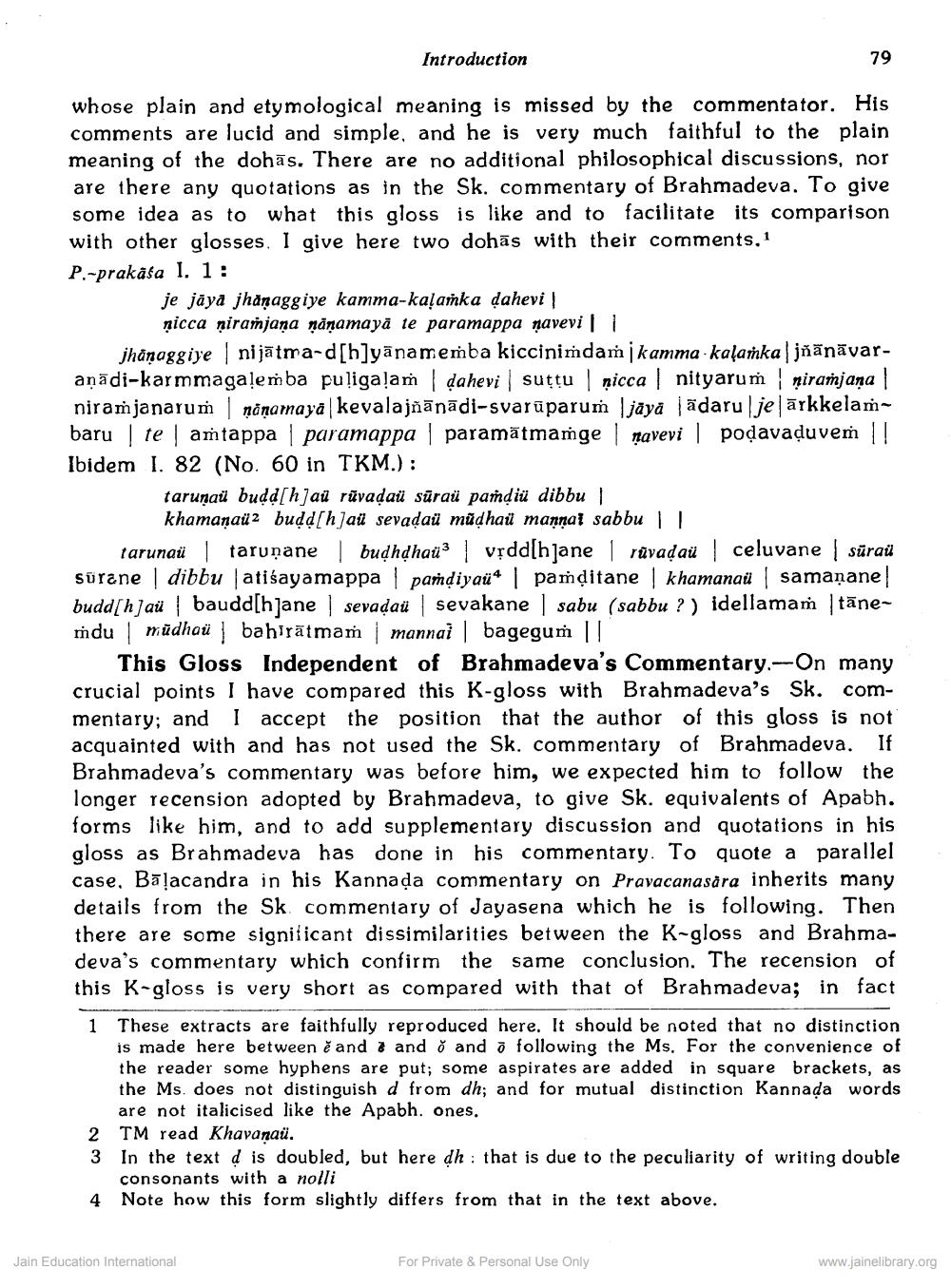________________
Introduction
79
whose plain and etymological meaning is missed by the commentator. His comments are lucid and simple, and he is very much faithful to the plain meaning of the dohās. There are no additional philosophical discussions, nor are there any quotations as in the Sk. commentary of Brahmadeva. To give some idea as to what this gloss is like and to facilitate its comparison with other glosses. I give here two dohäs with their comments, 1 P.-prakasa I. 1:
je jāya jhanaggiye kamma-kalamka dahevi
ņicca ņiramjaņa nānamayā te paramappa navevi i jhānaggiye nijātma-d[h]yānamemba kiccinimdami kamma kaļamkajñānāvaraņādi-karmmagalemba puliga!am | dahevi suttu nicca nityarum miramjana! niramjanarum nanamaya kevalajñāņādi-svarūparum jāyā jādaruje ārkkelambaru | tel amtappa | paramappa paramātmaṁge navevi | podavaduvem !! Ibidem I. 82 (No. 60 in TKM.) :
tarunaŭ budd[h]aü rūvadai sūrai pamdiü dibbu |
khamanaü2 budd[h]aü sevadaü müdhaü mannal sabbu | tarunaül tarunane budhdhaü3 vỉdd[hjane | rüvadaü celuvane | süraŭ Surane | dibbu atiśayamappa | pandiyaü" | pamditane | khamanaü | samanane budd[h]aü baudd[hjane sevadaü sevakane ) sabu (sabbu ?) idellamam tānemdu | müdhaü | bahirātmam | mannai | bagegum |||
This Gloss Independent of Brahmadeva's Commentary.--On many crucial points I have compared this K-gloss with Brahmadeva's Sk. commentary; and I accept the position that the author of this gloss is not acquainted with and has not used the Sk. commentary of Brahmadeva. If Brahmadeva's commentary was before him, we expected him to follow the longer recension adopted by Brahmadeva, to give Sk. equivalents of Apabh. forms like him, and to add supplementary discussion and quotations in his gloss as Brahmadeva has done in his commentary. To quote a parallel case, Bāacandra in his Kannada commentary on Pravacanasära inherits many details from the Sk commentary of Jayasena which he is following. Then there are some significant dissimilarities between the K-gloss and Brahmadeva's commentary which confirm the same conclusion. The recension of this K-gloss is very short as compared with that of Brahmadeva; in fact
1 These extracts are faithfully reproduced here. It should be noted that no distinction
is made here between 7 and X and ŏ and 7 following the Ms. For the convenience of the reader some hyphens are put; some aspirates are added in square brackets, as the Ms. does not distinguish d from dh; and for mutual distinction Kannada words
are not italicised like the Apabh. ones. 2 TM read Khavanaü. 3 In the text d is doubled, but here dh: that is due to the peculiarity of writing double
consonants with a nolli 4 Note how this form slightly differs from that in the text above.
Jain Education International
For Private & Personal Use Only
www.jainelibrary.org




